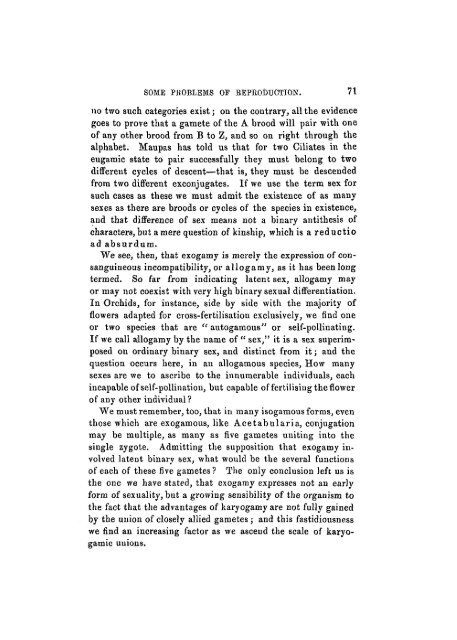Some Problems of Reproduction: a Comparative Study of ...
Some Problems of Reproduction: a Comparative Study of ...
Some Problems of Reproduction: a Comparative Study of ...
You also want an ePaper? Increase the reach of your titles
YUMPU automatically turns print PDFs into web optimized ePapers that Google loves.
SOME PKOBLEMS OF REPRODUCTION. 71<br />
no two such categories exist; on the contrary, all the evidence<br />
goes to prove that a gamete <strong>of</strong> the A brood will pair with one<br />
<strong>of</strong> any other brood from B to Z, and so on right through the<br />
alphabet. Maupas has told us that for two Ciliates in the<br />
eugamic state to pair successfully they must belong to two<br />
different cycles <strong>of</strong> descent—that is, they must be descended<br />
from two different exconjugates. If we use the term sex for<br />
such cases as these we must admit the existence <strong>of</strong> as many<br />
sexes as there are broods or cycles <strong>of</strong> the species in existence,<br />
and that difference <strong>of</strong> sex means not a binary antithesis <strong>of</strong><br />
characters, but a mere question <strong>of</strong> kinship, which is a reductio<br />
ad absurdum.<br />
We see, then, that exogamy is merely the expression <strong>of</strong> consanguineous<br />
incompatibility, or allogamy, as it has been long<br />
termed. So far from indicating latent sex, allogamy may<br />
or may not coexist with very high binary sexual differentiation.<br />
In Orchids, for instance, side by side with the majority <strong>of</strong><br />
flowers adapted for cross-fertilisation exclusively, we find one<br />
or two species that are " autogamous" or self-pollinating.<br />
If we call allogamy by the name <strong>of</strong> " sex," it is a sex superimposed<br />
on ordinary binary sex, and distinct from it; and the<br />
question occurs here, in an allogamous species, How many<br />
sexes are we to ascribe to the innumerable individuals, each<br />
incapable <strong>of</strong> self-pollination, but capable <strong>of</strong> fertilising the flower<br />
<strong>of</strong> any other individual?<br />
We must remember, too, that in many isogamous forms, even<br />
those which are exogamous, like Acetabularia, conjugation<br />
may be multiple, as many as five gametes uniting into the<br />
single zygote. Admitting the supposition that exogamy involved<br />
latent binary sex, what would be the several functions<br />
<strong>of</strong> each <strong>of</strong> these five gametes? The only conclusion left us is<br />
the one we have stated, that exogamy expresses not an early<br />
form <strong>of</strong> sexuality, but a growing sensibility <strong>of</strong> the organism to<br />
the fact that the advantages <strong>of</strong> karyogamy are not fully gained<br />
by the union <strong>of</strong> closely allied gametes j and this fastidiousness<br />
we find an increasing factor as we ascend the scale <strong>of</strong> karyogamic<br />
unions.

















